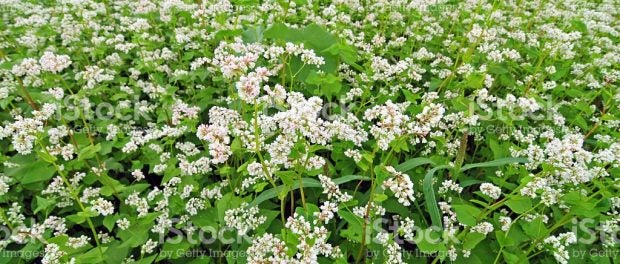Buckwheat Benefits Nature

Buckwheat Benefits Nature, By Blair Bryant
Buckwheat is good for more than just pancakes. It is an old-time crop that was once very popular, but its benefits are more valuable today than ever. Buckwheat isn’t actually a type of wheat. It’s a plant related to the rhubarb, and it’s easy to grow and helpful in many ways.
Buckwheat seeds are available at hardware stores and garden centers, and the inexpensive seeds are sold by the pound. The crop can be planted from spring after the danger of frost to mid August. Buckwheat doesn’t require special fertilizer and will even grow in poor soils, but the ground should be well-tilled before planting and have good drainage. Once the ground is ready, the seeds can be broadcast by the handful onto the soil. Although covering the seeds is an option, it isn’t necessary because buckwheat will self-sow. It’s a good idea to watch the weather forecast and plant the seeds a day before a scheduled rainfall. Seeds that are on top of the ground too long can be an easy feast for game birds. The seeds will usually sprout in as little as two to five days after a good rain, and no other care is needed.
One of the main uses of buckwheat is as a cover crop. Buckwheat is excellent for building up poor soil and choking out weeds. The crop can be tilled under any time, but it’s best to let it grow for six weeks or more. Buckwheat decays rapidly and adds nitrogen to the soil. The plants also take up phosphorus and make it more accessible to later crops that are planted in the same area. Even a second buckwheat crop can be planted over the first crop that was just tilled under to build up the soil even more. Using buckwheat as a cover crop was once a popular practice for the older generations, and it’s just as effective today.
In addition to helping the soil, buckwheat is also used to help the honey bees. Honey bee habitat has been reduced, so the busy bees will readily fly to a buckwheat crop. The bees like to work the small white flowers from around eight in the morning until about noon. This is the time when the nectar runs. It’s a beautiful sight to see so many bees in the buckwheat, and the sound of the swarm is amazing. Attracting honey bees with buckwheat will also benefit other crops that need pollination as the bees will continue to work other parts of the garden as well. More bees will result in more fruit and vegetable production. Planting a buckwheat crop in early to mid August will really help the honey bees during the tough month of September when nectar is hard to find. The late crop will boost honey production and help the bees make it through winter.
Honey bees aren’t the only wildlife to enjoy buckwheat. Rabbits and deer also like to feed on buckwheat, and wild turkeys will eat the seeds. Butterflies will also enjoy a buckwheat crop. The beautiful creatures will float from flower to flower and enjoy the sweet nectar. Property owners can enjoy the sight of the wildlife on their land and know that their crop is making a difference.
Growing a buckwheat crop can be a fun and rewarding summer project, and the benefits to nature are priceless. Anyone with a little land should give this simple crop a try.
Blair Bryant is a freelance writer and novelist.




 Your Privacy Choices
Your Privacy Choices
Leave a comment